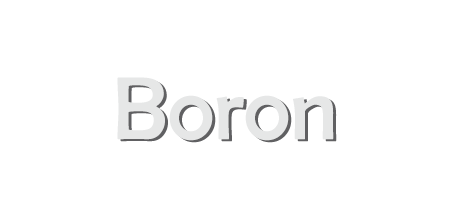
Most of the periodic elements we know are either chemically active or are involved in various different processes and procedures. However, there is one such element which is a tough element and is used as an essential nutrient for all the green plants. It is Boron. With a symbol ‘B’ and atomic number 5, Boron is very hard and resistant to heat. It belongs to Group 13 element, which means it is a borderline between the category of metals and non–metals. In simple words, Boron is semi–metallic and hence, it is rather a semiconductor rather than a metallic conductor. The element is chemically closer to silicon. It is the second hardest of all the elements in its crystalline form. Also, of all the elements, only about 11 elements have a higher melting point than Boron. The element is unusual as its atoms were not made by nuclear fusion within the stars but by nuclear fusion in cosmic–ray collisions. As it was produced in this cosmic–ray spallation, it is not abundantly found in both, the solar system and the earth’s crust. Boron, classified as a metalloid is not available naturally on earth.
For thousands of years, ancient cultures had known and used Boron compounds like Borax. The element was however, discovered by Sir Humphrey Davy (in London, UK) and Joseph–Louis Gay–Lussac in 1808 (in Paris, France). Their joint effort in isolating the element was accomplished through the reaction of boric acid with Potassium. In 1808, it was first partially isolated by French chemists Joseph L. Gay–Lussac and L.J Thenard and later, Sir Humphry Davy independently isolated it in London. The former reacted boric acid with magnesium or sodium to yield Boron, which is a grey solid. They observed that the element had shared characteristics with sulphur and phosphorous and hence, named it bore. Later in 1909, an American chemist Ezekiel Weintraub reduced Boron halides with Hydrogen and hence, was able to produce 99% pure Boron.

Distinctive characteristics of Boron include:
- The element does not occur naturally on earth but is available in the form of orthoboric acid, which is typically found in certain volcanic spring waters and as borates in Boron and colemantie.
- Boron is similar to carbon as it has the capacity to form stable, covalently bonded molecular networks.
- Boron being a semi–metallic, Boron nitride acts like an electrical insulator but conducts heat like a metal.
- At high temperatures, it is a good electrical conductor whereas at room temperatures, it is a poor conductor of electricity.
- Elemental Boron is not considered to be toxic and does not require special attention and handling.
- It can transmit few portions of infrared light.
Out of the 13 known isotopes of Boron, 7B is the shortest–lived and decays through proton emission and alpha decay. It has two naturally occurring isotopes. They are:
- 10B: It is often used to control fission in nuclear reactors as a neutron–capturing substance due to its high neutron cross–section. Enriched Boron is often useful in radiation shielding. Also, its primary nuclide is used in neutron capture therapy of cancer, which is a compound that contains 10B. The compound is incorporated into a pharmaceutical substance that is selectively taken up by a malignant tumour and the tissues near it.
- 11B: It produces three alpha particles and 8.7 MeV of energy when it is struck by a proton with a nuclear energy of about 500 KeV. Depleted Boron is a by–product of the nuclear industry and the isotope is also a candidate fuel for aneutronic fusion. The alpha particles from 11B can directly be turned into electric power and as soon as the reactor turns off, all the radiation stops. 11B is largely immune to radiation damage.
Pure Boron has been produced commercially. Boron is mainly found in ore Rasorite (Kernite) and Tincal (Borax ore) and in the Mojave Desert. Other areas that have extensive deposits of Boron and Borax are Turkey, Argentina, Bolivia and Chile. Impure or amorphous Boron, which is a brownish–black powder, can be produced by heating boron trioxide with magnesium powder. This is used to provide a distinctive green colour and is used in rockets as an igniter.
Boron is used for:
- One of the the most commercially important Boron compounds, Sodium Borax Pentahydrate is used in massive quantities in the manufacture of the insulation of fibreglass and sodium perborate bleach.
- The textile production relies on an important boron compound called the boric acid. Also, the compounds of Boron are widely used in the production of borosilicate glasses.
- Borax is used as a mild antiseptic and in laundry products.
- Boron filaments are used for advanced aerospace structures as they are high–strength and lightweight material.
- A material can be made with the use of Boron nitride, which is as hard as a diamond.
Boron is exposed to the humans through fruits and vegetables, water, air and consumer products. However, consuming large amounts of Boron through food may infect the stomach, liver, kidneys and brains and may eventually lead to death. Intake of small amounts of Boron may cause irritation of the nose, throat or eyes. Boron does not accumulate within the tissues of animals and hence, eating fish or meat will not increase the Boron concentrations in the human body.


